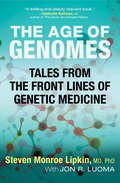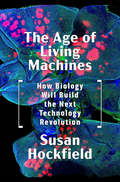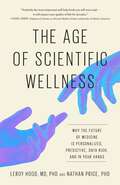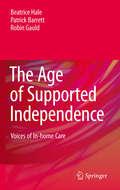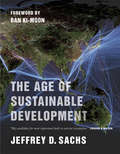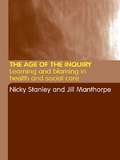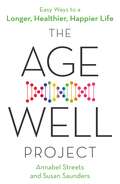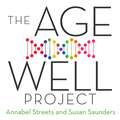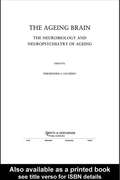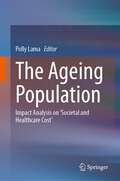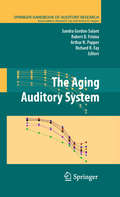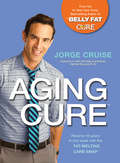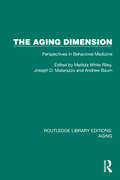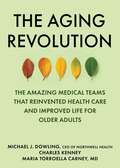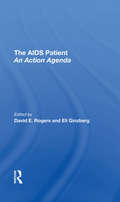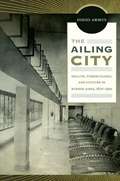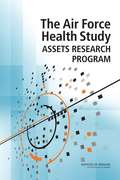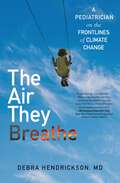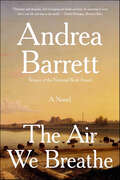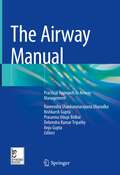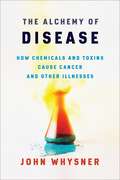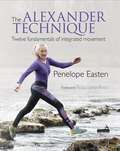- Table View
- List View
The Age of Genomes: Tales from the Front Lines of Genetic Medicine
by Steven Monroe Lipkin Jon LuomaA leading geneticist explores what promises to be one of the most transformative advances in health and medicine in historyAlmost every week, another exciting headline appears about new advances in the field of genetics. Genetic testing is experiencing the kind of exponential growth once seen with the birth of the Internet, while the plummeting cost of DNA sequencing makes it increasingly accessible for individuals and families.Steven Lipkin and Jon Luoma posit that today's genomics is like the last century's nuclear physics: a powerful tool for good if used correctly, but potentially dangerous nonetheless. DNA testing is likely the most exciting advance in a long time for treating serious disease, but sequencing errors, complex biology, and problems properly interpreting genetic data can also cause life-threatening misdiagnoses of patients with debilitating and fatal genetic diseases. DNA testing can also lead to unnecessary procedures and significantly higher health-care costs. And just around the corner is the ability to cure genetic diseases using powerful gene-editing technologies that are already being used in human embryo research. Welcome to the Age of Genomes!The Age of Genomes immerses readers in true stories of patients on the frontier of genomic medicine and explores both the transformative potential and risks of genetic technology. It will inform anxious parents increasingly bombarded by offers of costly new prenatal testing products, and demonstrate how genetic technology, when deployed properly, can significantly improve the lives of patients who have devastating neurological diseases, cancer, and other maladies. Dr. Lipkin explains the science in depth, but in terms a layperson can follow.
The Age of Living Machines: How Biology Will Build The Next Technology Revolution
by Susan HockfieldFrom the former president of MIT, the story of the next technology revolution, and how it will change our lives. A century ago, discoveries in physics came together with engineering to produce an array of astonishing new technologies: radios, telephones, televisions, aircraft, radar, nuclear power, computers, the Internet, and a host of still-evolving digital tools. These technologies so radically reshaped our world that we can no longer conceive of life without them. Today, the world’s population is projected to rise to well over 9.5 billion by 2050, and we are currently faced with the consequences of producing the energy that fuels, heats, and cools us. With temperatures and sea levels rising, and large portions of the globe plagued with drought, famine, and drug-resistant diseases, we need new technologies to tackle these problems. But we are on the cusp of a new convergence, argues world-renowned neuroscientist Susan Hockfield, with discoveries in biology coming together with engineering to produce another array of almost inconceivable technologies—next-generation products that have the potential to be every bit as paradigm shifting as the twentieth century’s digital wonders. The Age of Living Machines describes some of the most exciting new developments and the scientists and engineers who helped create them. Virus-built batteries. Protein-based water filters. Cancer-detecting nanoparticles. Mind-reading bionic limbs. Computer-engineered crops. Together they highlight the promise of the technology revolution of the twenty-first century to overcome some of the greatest humanitarian, medical, and environmental challenges of our time.
The Age of Scientific Wellness: Why the Future of Medicine Is Personalized, Predictive, Data-Rich, and in Your Hands
by Leroy Hood Nathan PriceTaking us to the cutting edge of the new frontier of medicine, a visionary biotechnologist and a pathbreaking researcher show how we can optimize our health in ways that were previously unimaginable.We are on the cusp of a major transformation in healthcare—yet few people know it. At top hospitals and a few innovative health-tech startups, scientists are working closely with patients to dramatically extend their “healthspan”—the number of healthy years before disease sets in. In The Age of Scientific Wellness, two visionary leaders of this revolution in health take us on a thrilling journey to this new frontier of medicine.Today, most doctors wait for clinical symptoms to appear before they act, and the ten most commonly prescribed medications confer little or no benefit to most people taking them. Leroy Hood and Nathan Price argue that we must move beyond this reactive, hit-or-miss approach to usher in real precision health—a form of highly personalized care they call “scientific wellness.” Using information gleaned from our blood and genes and tapping into the data revolution made possible by AI, doctors can catch the onset of disease years before symptoms arise, revolutionizing prevention. Current applications have shown startling results: diabetes reversed, cancers eliminated, Alzheimer’s avoided, autoimmune conditions kept at bay.This is not a future fantasy: it is already happening, but only for a few patients and at high cost. It’s time to make this gold standard of care more widely available. Inspiring in its possibilities, radical in its conclusions, The Age of Scientific Wellness shares actionable insights to help you chart a course to a longer, healthier, and more fulfilling life.
The Age of Supported Independence
by Patrick Barrett Beatrice Hale Robin GauldThis book investigates the experiences of older people who remain at home with care. It examines the transition points for the important life changes faced by family members who take on a greater care-giving role. The book draws on demographic analyses and qualitative fieldwork to explore the shift from independence to increasing dependence, and suggests that this transition constitutes movement into a new stage of life, that of an Age of Supported Independence. Applying the anthropological concept of rites of passage in their analysis, the authors focus on the changes in everyday living within the spatial environment of the home, the temporal organization of daily life, and the reshaping of relationships. They suggest that many older people - as well as the family members who become carers - remain in a state of 'liminality': unable to make sense of their new situation and experience and, despite assumptions that ageing-in-place sustains social connectedness, excluded from their communities.
The Age of Sustainable Development
by Jeffrey D. SachsJeffrey D. Sachs has shown himself to be one of the world's most perceptive and original analysts of global development in his groundbreaking books, including The End of Poverty and Common Wealth: Economics for a Crowded Planet. Now, in this major new work he presents a compelling and practical framework for how global citizens can address the seemingly intractable worldwide problems of persistent extreme poverty, environmental degradation, and political-economic injustice. Sachs outlines the holistic way forward: sustainable development. This provocative work offers readers, students, activists, environmentalists, and policy makers the tools, metrics, and practical pathways they need to achieve Sustainable Development Goals. Far more than a rhetorical exercise, this book is designed to inform, inspire, and spur action. Based on Sachs's twelve years as director of the Earth Institute at Columbia University, his thirteen years advising the United Nations secretary-general on the Millennium Development Goals, and his recent presentation of these ideas in a popular online course, The Age of Sustainable Development is a landmark publication and a clarion call for all who care about our planet and global justice.
The Age of Sustainable Development
by Jeffrey D. SachsJeffrey D. Sachs is one of the world's most perceptive and original analysts of global development. In this major new work he presents a compelling and practical framework for how global citizens can use a holistic way forward to address the seemingly intractable worldwide problems of persistent extreme poverty, environmental degradation, and political-economic injustice: sustainable development. <P><P>Sachs offers readers, students, activists, environmentalists, and policy makers the tools, metrics, and practical pathways they need to achieve Sustainable Development Goals. Far more than a rhetorical exercise, this book is designed to inform, inspire, and spur action. Based on Sachs's twelve years as director of the Earth Institute at Columbia University, his thirteen years advising the United Nations secretary-general on the Millennium Development Goals, and his recent presentation of these ideas in a popular online course, The Age of Sustainable Development is a landmark publication and clarion call for all who care about our planet and global justice.
The Age of the Inquiry: Learning and Blaming in Health and Social Care
by Nicky Stanley Jill ManthorpeThe plethora of inquiry reports published in the fields of health and welfare in the 1990s covered the full range of user groups, individuals and institutions. What similarities or differences were there between these inquiries? How effective were they in bringing about change? Whose interest did they best serve?These are some of the questions The Age of the Inquiry explores in detail, bringing together distinguished contributors with personal experience of chairing or providing evidence to inquiries to consider: the participant's view of inquiriesthe purpose of inquiriesthe impact of inquiries on health and social policyinquiries into: child abuse and death; homicides by mental health service users; the abuse of adults with learning disabilities; the abuse of older people. Wide-ranging in scope, The Age of the Inquiry focuses on service and policy development. It provides an invaluable text for students, teachers and professionals from a wide range of disciplines and professional groups.
The Age-Proof Brain: New Strategies to Improve Memory, Protect Immunity, and Fight Off Dementia
by Marc Milstein&“An absolutely fabulous, invaluable read!&” —Dr. James B. Maas, Weiss Presidential Fellow, former professor and chair of psychology, Cornell University &“A wonderful, life-changing book.&” —Brian Tracy, international bestselling author of Eat That Frog! Serious mental decline is not an inevitable part of aging. You can boost your short and long-term brain health and significantly lower the risk of dementia—if the right steps are taken now. Fifty million people have dementia worldwide, but it doesn&’t have to be that way. We—not our genes—can control our cognitive destiny. Serious mental decline is not an inevitable part of aging. You can boost your short- and long-term brain health and significantly lower the risk of dementia—if the right steps are taken now. In The Age-Proof Brain, scientist and popular speaker Dr. Marc Milstein reveals the secrets to improving brain function, which lie in the brain&’s surprising connection with the rest of the body. Debunking common misinformation, he offers science-driven strategies in an entertaining, motivating, and easy-to-follow guide to: Improve memory and productivity Increase energy and boost your mood Reduce the risk of anxiety and depression Form healthy habits to supercharge your brain Prevent nongenetic Alzheimer&’s and dementia Dr. Milstein arms you with knowledge about common and often overlooked issues that prematurely age the brain (including the surprising truth about what doctors previously got wrong about Alzheimer&’s and dementia), and shares a seven-day challenge to help you jump-start new brain-healthy habits. Small changes can make a big difference right away. The Age-Proof Brain will provide the tools you need to ensure that you&’re living a happier and more fulfilling life—today, tomorrow, and well into your future.
The Age-Well Project: Easy Ways to a Longer, Healthier, Happier Life
by Susan Saunders Annabel Streets'The essential mid-life mum makeover. From fitness to sleep and even your social life, a brilliant new book by two 50-something mothers reveals how to protect your health and happiness' Daily Mail'Educational and informative' Woman's WayAn essential handbook for making the second half of your life happy, healthy and disease-free.Diseases of older age take root decades before symptoms appear. For a longer, happier life, we need to plan ahead - but what exactly should we do?For five years, Annabel Streets and Susan Saunders immersed themselves in the latest science of longevity, radically overhauling their lives and documenting their findings on their popular blog.After reading hundreds of studies and talking to numerous experts, Annabel and Susan have compiled almost 100 short cuts to health in mid and later life, including: how, when and what to eat; the supplements worth taking; when, where and how to exercise; the most useful medical tests; how to avoid health-threatening chemicals; the best methods for keeping the brain sharp; and how to sleep better.
The Age-Well Project: Easy Ways to a Longer, Healthier, Happier Life
by Susan Saunders Annabel Streets'The essential mid-life mum makeover. From fitness to sleep and even your social life, a brilliant new book by two 50-something mothers reveals how to protect your health and happiness' Daily Mail'Educational and informative' Woman's WayDiseases of older age take root decades before symptoms appear. For a longer, happier life, we need to plan ahead - but what exactly should we do?For five years, Annabel Streets and Susan Saunders immersed themselves in the latest science of longevity, radically overhauling their lives and documenting their findings on their popular blog.After reading hundreds of studies and talking to numerous experts, Annabel and Susan have compiled almost 100 short cuts to health in mid and later life, including: how, when and what to eat; the supplements worth taking; when, where and how to exercise; the most useful medical tests; how to avoid health-threatening chemicals; the best methods for keeping the brain sharp; and how to sleep better.The Age-Well Project is an essential handbook for making the second half of your life happy, healthy and disease-free.
The Ageing Brain (Studies on Neuropsychology, Development, and Cognition)
by Perminder S. SachdevWhen confronted with a neurological or psychiatric disorder in an elderly individual, a clinician or researcher is likely to ask how the processes of ageing have influenced the aetiology and presentation of the disorder, and will impact on its efficient management. There are many urban myths about ageing, and some of these apply to the brain. The r
The Ageing Population: Impact Analysis on 'Societal and Healthcare Cost'
by Polly LamaAging is an irreversible natural process; we as humans develop many age-related disadvantages impacting many aspects of our life. Aging is not a negative process, but the ever-increasing band of the aging population creates a different socioeconomic and healthcare cost-associated risk that may hinder the sustainable development goals of any country and the world in general. Thus, the primary purpose of this book is to cover all aspects of the aging population. Each chapter in this book will give its readers a comprehensive understanding of how an aging population affects public programs such as pension plans, social welfare aids, healthcare costs, asset loss, and labor income, including chapters focusing on the demographic distribution of age-related diseases and injuries that increase healthcare cost, current social psychological reforms, and scientific research work adopted continent wise towards sustaining the aging population. Therefore, this book is helpful for students, teachers, and practitioners studying/working in the broad areas of social sciences, economics, and scientific research advancements in aging. This book serves as a bridge toward planning and developing new policies and practices.
The Aging Auditory System
by Robert D. Frisina Arthur N. Popper Sandra Gordon-Salant Richard R. FayThis volume brings together noted scientists who study presbycusis from the perspective of complementary disciplines, for a review of the current state of knowledge on the aging auditory system. Age-related hearing loss (ARHL) is one of the top three most common chronic health conditions affecting individuals aged 65 years and older. The high prevalence of age-related hearing loss compels audiologists, otolaryngologists, and auditory neuroscientists alike to understand the neural, genetic and molecular mechanisms underlying this disorder. A comprehensive understanding of these factors is needed so that effective prevention, intervention, and rehabilitative strategies can be developed to ameliorate the myriad of behavioral manifestations.
The Aging Cure: Reverse 10 Years In One Week With The Fat-melting Carb Swap
by Jorge CruiseFor years, experts have told you that if you want to look and feel younger, you must resort to surgeries, creams, or expensive vitamins. Others have told you to simply give up. They were WRONG. The solution is a diet that avoids hidden sugar and is rich in antioxidants. This easy guide makes anti-aging effortless and affordable. It includes more than 300 options customized for carb lovers, chicken and seafood fans, meat lovers, vegans, and vegetarians. Get ready for a fresh start to your life! Angie lost 92 lbs. Amy lost 40 lbs. Jorge lost 40 lbs.
The Aging Dimension: Perspectives in Behavioral Medicine (Routledge Library Editions: Aging)
by Andrew Baum Matilda White Riley Joseph D. MatarazzoOriginally published in 1987, this volume, and the working conference that preceded it, broke new ground in addressing the complex topic of aging, health, and behavior. Taking a bio-behavioral approach to a range of topics, contributors to this book advanced their disciplines. This volume as well as searching for important interfaces between behavior and health also added the dynamic aspect of aging. Cells, organ systems, and whole human beings all change as they move through life, linking health in varied and intricate ways to changes in behavior patterns, social structures, and cultural values and norms.
The Aging Revolution: The History of Geriatric Health Care and What Really Matters to Older Adults
by Charles Kenney Michael J. Dowling Maria Torroella CarneyA history of aging in the United States and an innovative blueprint for revolutionizing care for older adults from Northwell Health, New York&’s largest health care system. The New York Times described Dr. Robert Butler as &“the man who saw old age anew.&” In his 1975 book Why Survive: Being Old in America, Butler argued that for far too many people old age was &“a period of quiet despair . . . and muted rage&” and he set out to mitigate it. Nearly five decades since he penned his book, a devoted band of brilliant physicians and others in the healthcare field have realized at least a portion of Butler&’s dream: to recognize and alleviate suffering among the aging.The Aging Revolution is the story of Butler and his disciples: women and men who saw older distressed adults in hospitals and homes, and worse: being ignored by most of the medical establishment. These revolutionaries could not ignore the suffering, and they set out—individually and collectively—to create entirely new ways of caring for aging adults to ease their suffering and improve their quality and length of life. This revelatory book tells a story never-before told in its entirety, recounting the one of the most significant periods of improvement in American medical history. Readers will learn about pioneering individuals, concepts, and ideas that have improved the lives of millions, including: the women who placed the spotlight on delirium and falls—major issues for older adults; the campaign to build and spread Geriatric and Palliative Care; the small bands of doctors who worked the halls of Congress to create a new program that provides primary care along with home visits from healthcare professionals; and the New York-based foundation that has devoted its mission and millions exclusively to improving care and quality of life for aging adults. Today, as a result, chronic conditions that almost always accompany old age are far more manageable. Older people enjoy more options for work and professional development, for education, for leisure and travel, for sports and maintaining physical strength and mobility. For increasing numbers of Americans, life is healthier and richer in the experiences that matter most. Yet, aging in America can still be a challenge and, too often, particularly for the poor, a painful struggle. The range of mental and physical well-being has almost infinite variations: ninety-year-olds running marathons; sixty-five-year-olds incapacitated by stroke. While this book celebrates the incredible progress and strides made in this field, it also highlights areas that need improvement. The authors lay out specific steps that, if implemented, could ignite the aging revolution and diminish the total volume of older adults suffering in America.
The Aids Patient: An Action Agenda
by Eli Ginzberg David E. RogersThis volume seeks a better understanding of the issues and options involved in the generation and transfer of technology to poor small farmers. It is intended to provide a fresh opportunity to develop guidelines for the future design and implementation of rural development investment projects.
The Ailing City: Health, Tuberculosis, and Culture in Buenos Aires, 1870-1950
by Diego ArmusFor decades, tuberculosis in Buenos Aires was more than a dangerous bacillus. It was also an anxious state of mind shaped not only by fears of contagion and death but also by broader social and cultural concerns. These worries included changing work routines, rapid urban growth and its consequences for housing and living conditions, efforts to build a healthy "national race," and shifting notions of normality and pathology. In The Ailing City, the historian Diego Armus explores the metaphors, state policies, and experiences associated with tuberculosis in Buenos Aires between 1870 and 1950. During those years, the disease was conspicuous and frightening, and biomedicine was unable to offer an effective cure. Against the background of the global history of tuberculosis, Armus focuses on the making and consolidation of medicalized urban life in the Argentine capital. He discusses the state's intrusion into private lives and the ways that those suffering from the disease accommodated and resisted official attempts to care for them and to reform and control their morality, sociability, sexuality, and daily habits. The Ailing City is based on an impressive array of sources, including literature, journalism, labor press, medical journals, tango lyrics, films, advertising, imagery, statistics, official reports, and oral history. It offers a unique perspective on the emergence of modernity in a cosmopolitan city on the periphery of world capitalism.
The Air Force Health Study Assets Research Program
by Committee on the Management of the Air Force Health Study Data Specimens--Report to CongressThe Air Force Health Study (AFHS) is a longitudinal, prospective epidemiologic study of more than 2,700 men followed for approximately 20 years. This cohort participated in up to six intensive physical examinations with high rates of compliance. In addition to a complete record of clinical measurements and observations collected at these exams, serum and other biological samples were obtained and preserved. Extensive questionnaires addressing health, lifestyle, and socioeconomic status were administered during each exam, and other information was obtained about the participants' employment, families and offspring, and potential sources of environmental exposures. While the study was completed in 2006, the extensive health data linked to several types of longitudinally collected biologic specimens - some 91,000 serum, whole blood, urine, semen, and adipose tissue specimens - remain a resource for additional research. The AFHS assets are exceptional in the sheer multitude and range of types of information available for each participant. The longitudinal nature of the AFHS - with its extended follow-up, high rates of retention, and repeat biological samples - provides a valuable opportunity for research beyond the original aims of the study. Currently, the Institute of Medicine is the custodian of these assets. "The Air Force Health Study Assets Research Program" outlines the feasibility and advisability of maintaining the biospecimens based on interest generated from the general scientific community and results of pilot projects and other research projects using the AFHS assets. According to this report, sustaining access to the AFHS biospecimens and data benefits the veterans community and the public at large, who will gain from the information derived from studies of the assets. . This report discusses the scientific value of the AFHS data and biospecimens and the lessons learned in managing access to the assets.
The Air They Breathe: A Pediatrician on the Frontlines of Climate Change
by Debra HendricksonA timely, revelatory first look into the impact climate change has on children—the greatest moral crisis humanity faces today—by a pediatrician in the fastest warming city in America.Wildfires, hurricanes, and heat waves make headlines. But what is happening in Debra Hendrickson&’s clinic tells another story of this strange and unsettling time. Hendrickson is a pediatrician in Reno, Nevada—the fastest warming city in the United States, where ash falls like snow during summer wildfires. In The Air They Breathe, Dr. Hendrickson recounts patients she&’s seen who were harmed by worsening smoke, smog, and pollen; two boys in Arizona, stricken by record-setting heat while hiking; children who fled for their lives from Hurricane Harvey and the Tubbs Fire; and a little girl whose life was forever altered by the Zika virus outbreak in 2016. The climate crisis is a health crisis, and it is a health crisis, first and foremost, for children. Children&’s bodies are interwoven with and shaped by their surroundings. As the planet warms and their environment changes, children&’s health is at risk. The youngest are especially vulnerable because their brain, lungs, and other organs are forming and growing every day, and because their physiology is so different from that of adults. Childhood has always been a risky period of life; throughout history, babies and children have met peril, from polio to famine, from cyclones to war. Yet they have never quite had to face, in quite this way, the potential loss of the future itself. The Air They Breathe is not just about the health impacts of global warming, but something more: a soul-stirring reminder of our moral responsibility to our children, and their profound connections to this unique and irreplaceable world.
The Air We Breathe: A Novel
by Andrea Barrett"Turbulent and dramatic, full of longing and death and lust, the yearning to cover one’s own life and way in the world." —David Mehegan, Boston Globe An elegant and astute tale of desire and betrayal, science and medicine, from the "genius enchantress" (Karen Russell) author of Ship Fever, winner of the National Book Award.In the fall of 1916, America prepares for war—but in the town of Tamarack Lake, the focus is on the sick. Wealthy tubercular patients live in private cure cottages; charity patients, mainly immigrants, fill the large public sanatorium. From within their isolated community, they grapple with some of the most thrilling scientific discoveries of their time—X-ray technology, chemical and biological weapons, changing theories of atomic structure—and their limitations. Prisoners of routine, they take solace in gossip, rumor, and, sometimes, secret attachments. When the well-meaning efforts of one enterprising patient lead instead to a tragic accident and a terrible betrayal, the war comes home, bringing with it a surge of anti-immigrant prejudice. With The Air We Breathe, Andrea Barrett has crafted a "majestic, breathtaking, [and] thrilling" (San Diego Union-Tribune) novel that brilliantly illuminates the inescapable heartbreak of war.
The Airliner Cabin Environment And The Health Of Passengers And Crew
by Committee on Air Quality in Passenger Cabins of Commercial AircraftAlthough poor air quality is probably not the hazard that is foremost in peoples’ minds as they board planes, it has been a concern for years. Passengers have complained about dry eyes, sore throat, dizziness, headaches, and other symptoms. Flight attendants have repeatedly raised questions about the safety of the air that they breathe.The Airliner Cabin Environment and the Health of Passengers and Crew examines in detail the aircraft environmental control systems, the sources of chemical and biological contaminants in aircraft cabins, and the toxicity and health effects associated with these contaminants. The book provides some recommendations for potential approaches for improving cabin air quality and a surveillance and research program.
The Airway Manual: Practical Approach to Airway Management
by Prasanna Udupi Bidkar Nishkarsh Gupta Raveendra Shankaranarayana Ubaradka Debendra Kumar Tripathy Anju GuptaThe book provides up-to-date and easy to understand information on airway management with special emphasis on practical management along with required theory background and key points. It covers all aspects of airway management including education, training, audit, controversies, recent advances, case discussion, etc. The book covers all the techniques of airway management like the use of video laryngoscopy, fibre-optic intubation, and retrograde intubation. Further, the book includes a chapter on airway management during transmittable infectious diseases, such as COVID-19. The book also includes separate chapters on the available guidelines; discussion of interesting cases; neonatal airway; and out of hospital airway management. The book is written by experienced authors keeping in mind the unique problems and situations related to this specialized and vital area of patient management. It presents summary and key points in each chapter. Overall, this book provides practical, specialty oriented and patient centered approach to airway management. The book is a useful resource for postgraduate students, residents and fellows in anesthesia, emergency medicine, critical care medicine. It is also relevant for anesthesiologists, intensivists, emergency physicians and internal medicine physicians.
The Alchemy of Disease: How Chemicals and Toxins Cause Cancer and Other Illnesses
by John WhysnerSince the dawn of the industrial age, we have unleashed a bewildering number of potentially harmful chemicals. But out of this vast array, how do we identify the actual threats? What does it take to prove that a certain chemical causes cancer? How do we translate academic knowledge of the toxic effects of particular substances into understanding real-world health consequences? The science that answers these questions is toxicology.In The Alchemy of Disease, John Whysner offers an accessible and compelling history of toxicology and its key findings. He details the experiments and discoveries that revealed the causal connections between chemical exposures and diseases. Balancing clear accounts of groundbreaking science with human drama and public-policy relevance, Whysner describes key moments in the development of toxicology and their thorny social and political implications. The book features discussions of toxicological problems past and present, including DDT, cigarettes and other carcinogens, lead poisoning, fossil fuels, chemical warfare, pharmaceuticals—including opioids—and the efficacy of animal testing. Offering valuable insight into the science and politics of crucial public-health concerns, The Alchemy of Disease shows that toxicology’s task—pinpointing the chemical cause of an illness—is as compelling as any detective story.
The Alexander Technique: Twelve fundamentals of integrated movement
by Penelope EastenThis book gets back to the core of the Alexander Technique (AT), much of which is not known even to most teachers. This is because Alexander (1869-1955) changed what he was doing at least three times, around 1912, 1923, and 1930, each time leaving key elements behind, unexplained. These lost elements include natural breathing, his biomechanics to alter the body for ourselves, the real thought processes of his directions, how he used inhibition and quiet attentiveness to discover intrinsic movement patterns, and how he used vision as part of his process. There are snippets of AT history throughout, and a potted history of what really happened in the AT, as it has not been told before, but the emphasis is on AT in the context of integrated movement.
